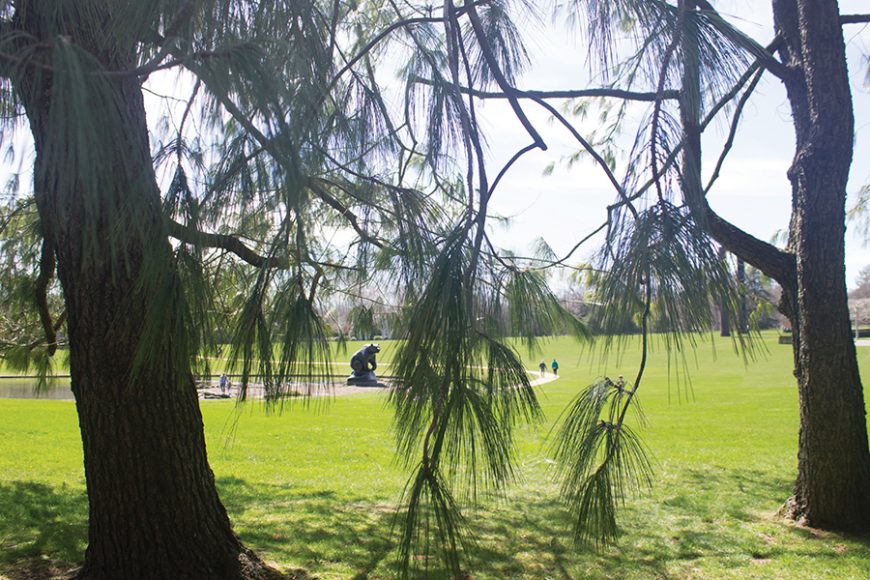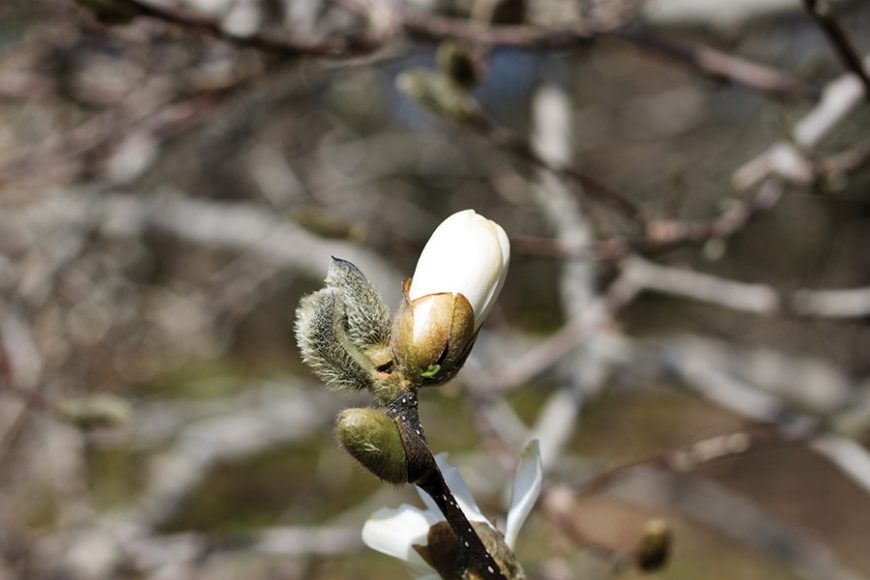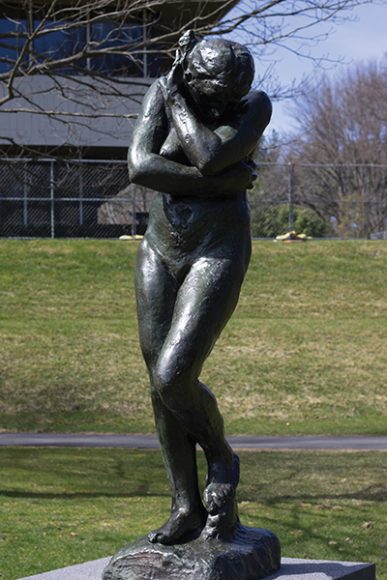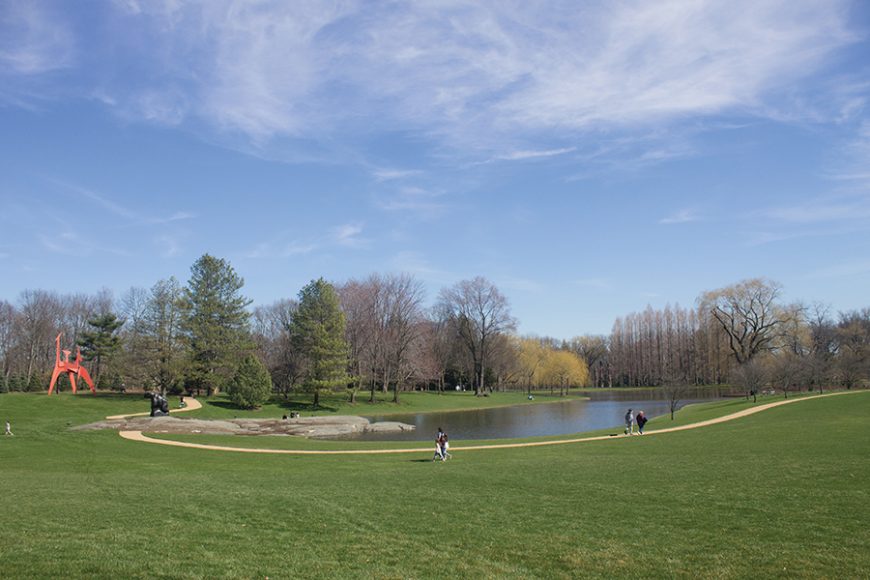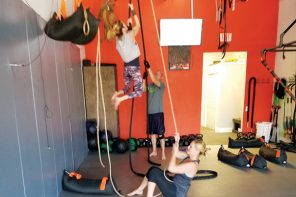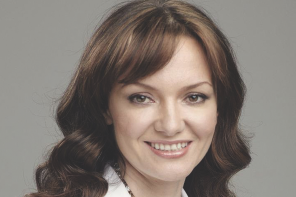I would walk there in every season and for every reason, on the sunny days of the soul — and the rainy ones as well.
Down the serpentine, pebbled and woodchip paths I would trip, reveling in the sensuousness of dancing nude sculptures, pink and white blossoms and magnolia trees, buoyant water lilies, swaying tall grasses and vibrant irises.
Perhaps just as striking were the people I would observe — children running headlong toward the manmade lake, enticed by David Wynne’s “Grizzly Bear;” bridal parties posing proudly before the sculptor’s “The Dancers” in the shadow of weeping willows; seniors exchanging confidences in the Lily Pond Garden; and female walkers grinning back at me, acknowledging a kindred spirit.
Once I encountered a handsome jogger who smiled at me as we passed each other. It took me a minute to realize it was former New York Yankee right fielder Paul O’Neill.
For a long time afterward, I avoided the Donald M. Kendall Sculpture Gardens at PepsiCo in Purchase: It had not only been one of my go-to places for communing with nature, along with Rye Town Park; it was also a place I shared with Aunt Mary, my beloved Tiny. We would sit on the patio on Sunday afternoons, reading and gazing out at the lake and the fountain or eavesdropping on some fellow visitor’s radio broadcast of the Yankee game. Or she’d read and I’d walk. Toward the end of her life, she’d sit in the car in the parking lot and I’d walk less, always anxious to get back to her.
When she died in 2011, I couldn’t bear the old haunts, and perhaps it was just as well. The gardens — named for the PepsiCo chairman and CEO who had conceived of them as a gift to the community and a reflection of the company’s stable, creative and experimental place in it — closed to the public in 2012 as the company’s world headquarters underwent a major renovation. It was, to my mind, just another instance of a chapter closing.
But gardens are about renewal. Something dies. Something else is born. When I heard that the Sculpture Gardens would reopen to the public at the end of March, so early in the spring, I thought, So much has changed in my life. Would the same be true for Pepsi?
Perhaps the biggest change to the 168-acre site is one of security. In the past, you were issued a green pass to display in your car and told to park in a side parking lot (or near the Visitor Center if you had a handicap sticker). You’d see people walking dogs on the paths, tossing Frisbees on the lawn or biking on the roads. Gradually, restrictions tightened at the company’s world headquarters with 9/11 providing a definite shift, as it did everywhere.
Now you are given a color brochure/map and asked to display a laminated sheet of dos and don’ts — single-spaced on both sides — with liability clauses. I read the sheet and took note of the side parking lot, now fortified with a brick wall, a railing and steps. “Just a few improvements,” a security guard said with classic understatement at the Visitor Center. But then, PepsiCo has always been about innovation, ever since the building — seven square blocks designed by Edward Durrell Stone (1902-78) to rise from the ground in low, inverted ziggurats — opened in 1970 on land that was once a polo field. His son, E.D. Stone Jr., had been charged with laying out the surrounding landscape. Then in 1980, Russell Page (1902-85) began to extend the gardens — relating the (now 46) 20th-century works, representational and abstract, to the landscape and using fragrant trees, shrubs and herbaceous plants to tickle the nostrils as well as delight the eye in all seasons.
Since 1985, garden designer François Goffinet has continued the Sculpture Gardens’ evolution, which was apparent right at the Visitor Center, where you are now greeted by Wynne’s “Girl on a Horse.” (He is the most represented artist in the Gardens with five sculptures.) In the past, “Girl on a Horse” watched over one of the three sunken gardens that framed a circular fountain crowned by Wynne’s “Girl With a Dolphin” in the entrance courtyard. The three sunken gardens included one teeming with small stones and blossoming trees graced by Aristide Maillol’s female nude “Marie;” one filled with water and plantings presided over by Henri Laurens’ “Le Matin” and “Les Ondines;” and one made of a checkerboard of stone and grass containing Jacques Lipchitz’s “Towards a New World.” Were my old friends still there?
Alas, the approach to the courtyard entrance — which now features a rectangular pool with grasses and a fountain — was off-limits due to construction, a guard politely informed me. But I could see by the map that some of my old pals had been relocated to other portions of the Gardens. So I assumed they were happily ensconced, and stuck to Page’s “Golden Path,” knowing I would encounter some of them and hoping to make new friends.
I wasn’t disappointed, soon encountering Surrealist artist Leonora Carrington’s “Musica Para Sordos (Music for the Deaf)” (2006-07), a bronze that depicts a medieval figure playing a harp with no strings in the Fall Garden. As I hustled along, I marveled at the effects of the renovation: Judith Brown’s titanium “Caryatids” gleamed with pink and blue glints I’d never noticed before.
But though “much is taken,” I thought, one with Tennyson’s Ulysses, “much abides.” Wynne’s “Dancer With a Bird” still balanced on one leg amid the pines. And across the way, beyond a bower leading to the Stream Garden, the nude youth in Victor Salmones’ “The Search” continued to sleepwalk, his outstretched arms bearing a mask of his face. I used to think his was a quest for the unattainable self. But now I see the mask as a calling card as he exhorts us “to strive, to seek, to find and not to yield.”
The Donald M. Kendall Sculpture Gardens at PepsiCo are on Anderson Hill Road, across from Purchase College. Hours are 10 a.m. to 4 p.m. weekends. For more, call 914-253-2000.

